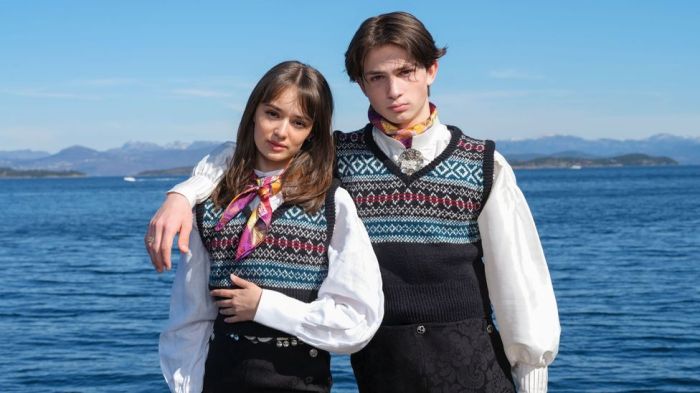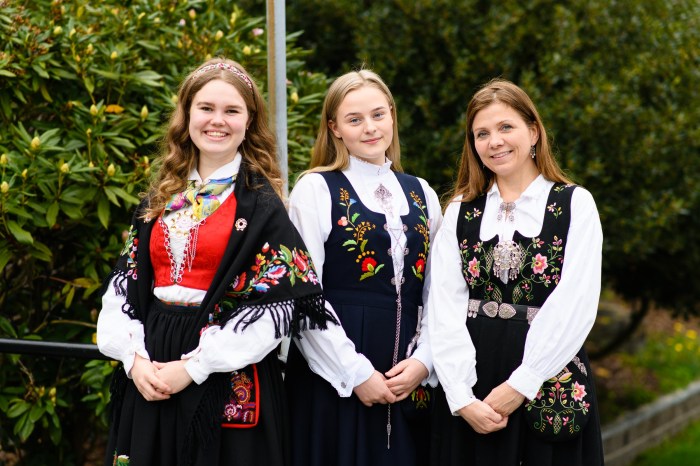Traditional Nordic Wedding Dress A Timeless Elegance
Historical Evolution of the Nordic Wedding Dress

Source: co.uk
Traditional nordic wedding dress – The Nordic wedding dress, reflecting the rich tapestry of cultural heritage across Norway, Sweden, Denmark, Finland, and Iceland, has undergone a fascinating evolution. Early forms were deeply rooted in practicality and local traditions, evolving over centuries to incorporate international influences while retaining distinct regional characteristics.
Evolution of Nordic Wedding Dress Styles
From the 18th and 19th centuries, Nordic wedding dresses primarily utilized locally sourced materials like linen and wool, reflecting the agricultural economies of the region. Silhouettes were typically simple, often featuring long sleeves and modest necklines. Embellishments were minimal, often consisting of simple embroidery or hand-stitched details. The 20th century saw the influx of international styles, particularly from France and the United Kingdom, leading to more elaborate designs incorporating lace, beading, and more varied silhouettes.
Post-World War II, a move towards simpler, more streamlined designs emerged, influenced by New Look fashion. Contemporary Nordic wedding dresses retain elements of traditional aesthetics while embracing modern design trends.
Regional Variations in Traditional Nordic Wedding Attire
While sharing common Nordic threads, significant regional variations exist. Norwegian bridal attire often featured intricate embroidery and distinctive regional patterns, reflecting the country’s strong folk traditions. Swedish dresses, particularly in the southern regions, showcased more elaborate lacework and embellishments. Danish designs often incorporated elements of both German and French influences, resulting in a blend of styles. Finnish dresses frequently featured darker colours and simpler designs compared to their southern neighbours, influenced by the country’s natural environment.
Icelandic dresses, historically reflecting practicality, often utilized darker wool fabrics with minimal ornamentation.
Timeline of Nordic Wedding Dress Design Changes
| Era | Key Features | Notable Influences | Representative Image Descriptions |
|---|---|---|---|
| Pre-1800s | Simple silhouettes, locally sourced fabrics (linen, wool), minimal embellishment. | Local folk traditions, practical considerations. | A long, dark wool dress with simple embroidery, perhaps a shawl or apron. |
| 1800s-1920s | More elaborate designs, introduction of lace and other embellishments, influence of Romantic and Victorian styles. | European fashion trends, particularly from France and England. | A long white dress with lace trim, possibly a fitted bodice and full skirt. |
| 1920s-1950s | Streamlined silhouettes, influence of Art Deco and New Look styles, use of lighter fabrics. | International fashion trends, post-war optimism. | A knee-length dress with a dropped waistline, perhaps featuring geometric patterns. |
| 1950s-Present | Diverse styles, blending traditional elements with modern designs, experimentation with fabrics and silhouettes. | Contemporary fashion trends, revival of traditional crafts. | A variety of styles, from minimalist gowns to those incorporating traditional embroidery and lace. |
Key Design Elements of a Traditional Nordic Wedding Dress
Several defining characteristics distinguish a traditional Nordic wedding dress. Understanding these elements allows for a deeper appreciation of the cultural significance and artistry embedded within these garments.
Defining Characteristics of Traditional Nordic Wedding Dresses
Traditional Nordic wedding dresses often featured long sleeves, high necklines (often boat necks or high collars), and a relatively modest silhouette. The overall aesthetic leaned towards elegance and simplicity, emphasizing the quality of the materials and craftsmanship rather than excessive ornamentation. Length typically reached the floor or ankle, depending on the era and regional style.
Traditional Nordic Embroidery, Lace, and Embellishments, Traditional nordic wedding dress
Intricate embroidery played a crucial role, often featuring traditional Nordic floral motifs or geometric patterns. These patterns held symbolic meaning, sometimes representing fertility, prosperity, or protection for the couple. Lace, particularly hand-made lace, was another important embellishment, adding a delicate and refined touch. Other embellishments might include ribbons, beads, or even silver or gold accents, depending on the region and the bride’s family’s means.
Modern Interpretations of Traditional Nordic Wedding Dresses
- Variation 1: Minimalist Elegance: A floor-length gown in ivory linen, featuring delicate hand-embroidered floral motifs along the neckline and sleeves. Simple, elegant silhouette with a high neckline and long sleeves.
- Fabric: Linen
- Embellishments: Hand-embroidered floral motifs
- Aesthetic: Clean, minimalist, elegant.
- Variation 2: Romantic Lace: A flowing A-line gown in silk, adorned with intricate antique-style lace detailing along the bodice and skirt. Long sleeves, modest V-neckline.
- Fabric: Silk
- Embellishments: Antique-style lace
- Aesthetic: Romantic, ethereal, delicate.
- Variation 3: Bold Embroidery: A fitted gown in wool, showcasing bold, colorful embroidery inspired by traditional Nordic patterns across the bodice and skirt. Three-quarter sleeves, round neckline.
- Fabric: Wool
- Embellishments: Bold, colorful embroidery
- Aesthetic: Modern, vibrant, bold.
Materials and Craftsmanship: Traditional Nordic Wedding Dress
The materials and craftsmanship employed in creating traditional Nordic wedding dresses were integral to their beauty and cultural significance. The choice of materials and techniques reflected both the region’s resources and the skill of its artisans.
Traditional Materials in Nordic Wedding Dresses
Linen, a durable and breathable fabric, was a staple in many Nordic regions. Wool, providing warmth and comfort, was particularly common in colder climates. Silk, a luxurious material, was used less frequently, reserved for more affluent brides. The choice of fabric often reflected the bride’s social standing and the region’s resources. The significance of these materials extended beyond their practical use, symbolizing aspects of nature, resilience, and prosperity within Nordic culture.
Traditional Handcraftsmanship Techniques

Source: thespurtrail.com
Weaving, embroidery, and lacemaking were essential handcraftsmanship techniques. Weaving created the base fabric, often using intricate patterns. Embroidery added decorative elements, often with symbolic meanings. Lacemaking, a time-consuming and skilled craft, created delicate and ornate details. These techniques, passed down through generations, ensured the unique character of each dress.
Contemporary Designers Incorporating Traditional Nordic Craftsmanship
Many contemporary designers are incorporating traditional Nordic craftsmanship into their modern designs. For instance, some designers use traditional weaving techniques to create unique textiles for their gowns, while others collaborate with artisans to create hand-embroidered or lace details. This approach ensures the continuation of traditional crafts while simultaneously creating modern and stylish wedding dresses. Examples include designers who highlight intricate smocking techniques or use locally sourced, naturally dyed fabrics in their collections.
Symbolic Meaning and Cultural Significance
The colors, patterns, and overall design of a traditional Nordic wedding dress carried deep symbolic meaning within the context of Nordic wedding traditions. Understanding these symbols provides insight into the cultural values and beliefs associated with marriage.
Symbolic Meaning of Colors and Patterns
Colors like white symbolized purity and innocence, while other colors, depending on the region, held different meanings. Floral motifs often represented fertility and abundance, while geometric patterns could symbolize protection or good fortune. The specific meanings varied across regions and often reflected local folklore and beliefs. Certain colours were associated with specific regions or families.
Role of the Wedding Dress in Nordic Wedding Ceremonies
The wedding dress was more than just attire; it was a symbol of the bride’s status and role within the community. The quality of the dress, its materials, and its craftsmanship reflected the bride’s family’s social standing and economic resources. The dress played a central role in the ceremony, representing the bride’s transition into marriage and her new role within her husband’s family.
Comparison with Other European Wedding Traditions
Compared to other European wedding traditions, Nordic wedding dresses often featured a more understated elegance. While other cultures might emphasize elaborate ornamentation and dramatic silhouettes, Nordic traditions often favored simplicity and quality of craftsmanship. However, the use of symbolic patterns and motifs is a common thread across many European wedding traditions, reflecting the shared history and cultural exchange within the continent.
Modern Interpretations of the Traditional Nordic Wedding Dress
Contemporary designers are creatively reinterpreting traditional Nordic wedding dress elements, resulting in a range of modern designs that honor the past while embracing contemporary aesthetics.
Contemporary Designers and Their Reinterpretations
Many designers are incorporating traditional Nordic elements into their collections, such as using locally sourced fabrics, incorporating traditional embroidery or lace, or referencing traditional silhouettes in a contemporary way. Some designers focus on minimalist aesthetics, highlighting the quality of the materials and craftsmanship, while others create more elaborate designs that showcase intricate details and unique embellishments. The approaches are diverse, reflecting the breadth of contemporary design styles.
Current Trends in Nordic Wedding Fashion
Current trends in Nordic wedding fashion reflect a growing appreciation for sustainable and ethically sourced materials, as well as a renewed interest in traditional craftsmanship. Many brides are incorporating traditional elements, such as embroidery or lace, into their modern gowns, creating a unique blend of old and new. The emphasis is often on timeless elegance and simplicity, with a focus on quality and sustainability.
Collection of Images Illustrating Modern Interpretations
| Designer | Image Description | Key Design Elements | Materials |
|---|---|---|---|
| [Designer Name 1] | A flowing A-line gown in organic cotton, featuring delicate hand-embroidered floral motifs along the neckline and sleeves. | A-line silhouette, long sleeves, high neckline, hand-embroidered details. | Organic cotton, hand-embroidered details. |
| [Designer Name 2] | A fitted gown in linen, with intricate lace detailing along the bodice and sleeves. A simple, elegant silhouette. | Fitted silhouette, long sleeves, high neckline, intricate lace details. | Linen, lace. |
| [Designer Name 3] | A minimalist gown in silk, featuring a simple, elegant silhouette with subtle embroidery inspired by traditional Nordic patterns. | Simple silhouette, long sleeves, high neckline, subtle embroidery. | Silk, subtle embroidery. |
FAQs
What are some common colors used in traditional Nordic wedding dresses?
While colors vary regionally, whites, creams, and light pastels are common, reflecting purity and innocence. Deep blues and greens, representing nature, also appear.
Are there specific floral motifs often incorporated?
Yes, floral motifs, particularly those representing local flora, are frequent. Think stylized depictions of wildflowers, branches, and leaves.
How does the climate influence the fabrics used?
Traditional Nordic wedding dresses often feature simple, elegant silhouettes and natural fabrics. While these designs typically embrace muted tones, a modern bride might consider a bolder approach, perhaps drawing inspiration from a vibrant color scheme like that showcased in articles on purple and red dress for wedding. This unexpected contrast could add a unique twist to a classic Nordic aesthetic, resulting in a truly memorable wedding ensemble.
Ultimately, the choice reflects the bride’s personal style and preference.
Historically, warmer fabrics like wool were common in colder climates, while lighter linens were used in warmer regions. Modern designs utilize a broader range of fabrics.
Where can I find modern designers who incorporate traditional Nordic elements?
Searching online for “Scandinavian bridal designers” or “Nordic wedding dress designers” will reveal contemporary designers incorporating traditional elements.





















